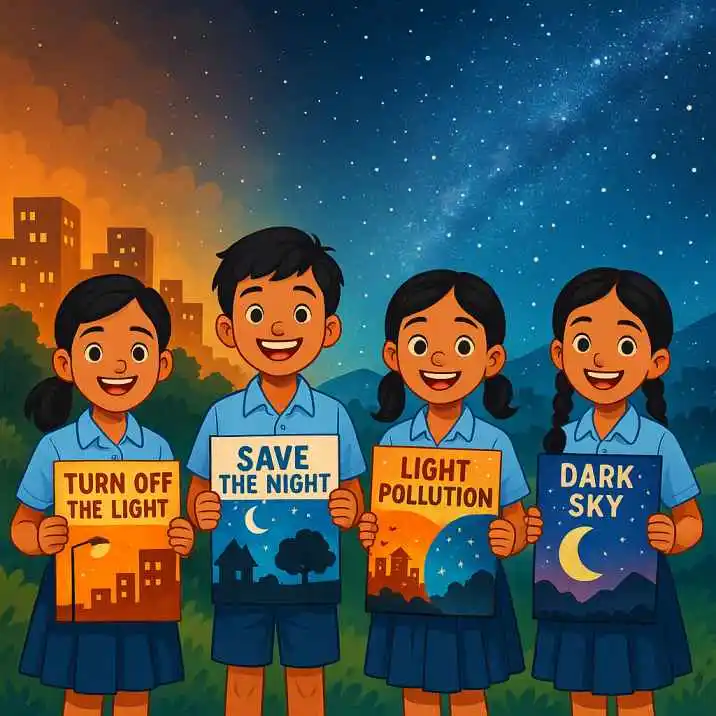🌌 Introduction
Have you ever looked up at the night sky from a city and wondered, “Where did all the stars go?” You’re not alone. Across India and the world, city lights are dimming our view of the cosmos—and harming our health and ecosystems in the process. This growing problem is known as light pollution, and the global effort to fight it is called the Dark Sky Movement.
But how do you explain such a technical issue to children, families, or even your neighbors? Drawings and visual art have emerged as powerful tools to make light pollution easy to understand—and hard to ignore.
In this blog, we’ll explore how simple sketches, infographics, and school projects are helping people visualize light pollution and take action. Whether you’re a student working on an environmental science assignment, a Gen Z changemaker on Instagram, or a parent looking to reduce light waste at home, this guide is for you.
By the end, you’ll not only understand the science behind the Dark Sky Movement, but also discover creative, Indian-friendly ways to spread awareness using art. Ready to draw a brighter (and darker) future?
👉 Download our Free Dark Sky Drawing Worksheet – GreenGlobe25
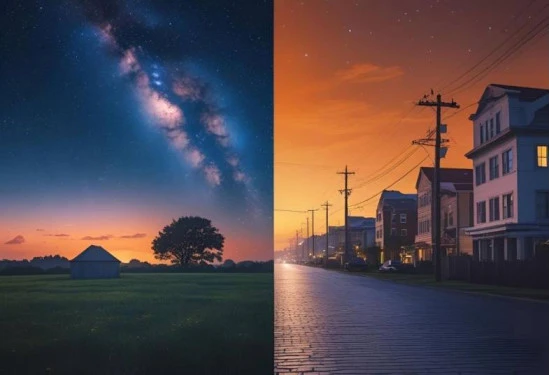
Table of Contents
🌠 Section 1: What is the Dark Sky Movement?
🌍 Origins and Global Significance: The Dark Sky Movement is a global initiative aimed at reducing light pollution and preserving our natural night skies. It began in the 1980s when astronomers started noticing that artificial lighting from cities was making it harder to observe stars. Over time, scientists, environmentalists, and everyday citizens joined forces to protect not just the stars but also wildlife, human health, and energy resources.
Today, organizations such as the International Dark-Sky Association (IDA) work worldwide to promote more sustainable lighting practices. Their goal is simple: reduce unnecessary outdoor lighting that spills into the night sky. Countries like the U.S., France, and South Korea already have dark sky parks and strict light regulations. Now, this movement is growing in India too.
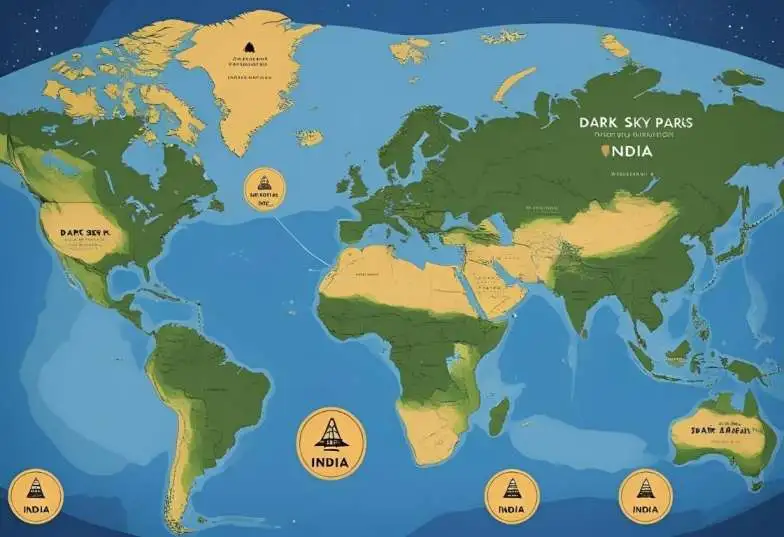
🇮🇳 Why It Matters in India Today. Light pollution is rising fast, especially in metro cities like Mumbai, Delhi, and Bengaluru. While we celebrate Diwali and enjoy urban development, we often overlook the side effects of excessive lighting:
- Disruption of sleep cycles and mental health
- Confusion in migratory birds and insects
- Wasted electricity and carbon emissions
- Disconnection from nature and astronomy
For a country with deep spiritual ties to the stars—from ancient astronomy in Varanasi to stargazing in Ladakh—this loss is cultural as well as environmental.
Luckily, Indian voices are joining the movement. Cities like Pune and Bhopal have started local “dark sky” events. Even school kids are taking part by making drawings and posters to raise awareness. These small steps help reclaim our night skies—one streetlight and sketch at a time.
🎨 Section 2: Understanding Light Pollution Visually
💡 Types of Light Pollution (with Drawing Ideas) Light pollution isn’t just one kind of glow—it comes in several forms, each with a unique impact on the night sky and our lives. Visualizing these through drawings or infographics can make them easier to understand, especially for students and beginners.
Here are the main types of light pollution, along with simple drawing ideas for each:
Skyglow: What it is: The orange or white haze you see above cities. Drawing idea: A split image showing a star-filled rural sky vs. a washed-out city sky.
Glare: What it is: Excessively bright light that causes visual discomfort. Drawing idea: A streetlight shining directly into someone’s eyes, blocking their view of the stars.
Light Trespass What it is: Light spilling into areas where it’s not needed, like streetlights shining into bedrooms. Drawing idea: A house at night with light beams crossing into the windows.
Clutter: What it is: Too many bright lights in a small area, like flashy billboards or shops. Drawing idea: A busy urban street overloaded with neon lights, with no stars in sight.
These simple visuals can spark empathy and start conversations, especially when used in school exhibitions or online posts.
Want to see how light pollution affects your area? Try the interactive Light Pollution Map to explore sky brightness across the globe.
🖼️ How Art and Infographics Make Awareness More Powerful. A drawing can say what a thousand words can’t. For visual learners or children, art is an easy entry point into complex environmental topics. In India, where literacy and language barriers exist, images break down information and reach wider audiences.

Here’s how visual storytelling helps:
- Creates emotional impact – A child’s drawing of a starless sky touches hearts.
- Encourages sharing on social media – Infographics get reposted and go viral.
- Engages all ages – Kids, teens, parents, and even seniors can relate.
Schools and NGOs are using posters, comic strips, and reels to make the Dark Sky Movement more accessible. And the best part? You don’t have to be an artist. Even a basic sketch can spread a big awareness.
Students and teachers can also participate in Globe at Night, a citizen science project where you measure night sky visibility in your neighborhood.
✏️ Section 3: How Drawings Help Educate & Mobilize Action
🎒 School Projects & Student Activism In India, environmental education is gaining momentum, and schools play a huge role in shaping young minds. Art-based projects—like light pollution drawings, posters, and model displays—are becoming popular ways to introduce students to the Dark Sky Movement.
Educators and environmental clubs can use drawing worksheets to teach these concepts. Supplement your lessons with Project Learning Tree’s light pollution activities and the free SciStarter classroom resources.

Here’s how drawings help in schools:
- Simplify complex topics – Students grasp ideas like “skyglow” or “light trespass” faster when they draw them.
- Boost creativity – Kids combine science with art, making learning fun and memorable.
- Encourage teamwork – Group projects like creating a dark sky exhibition build collaboration.
- Spark activism – Many students go beyond classrooms and present their work during science fairs or environmental awareness days.
💡 Real Example: In Hyderabad, a group of Class 8 students created a “Glow vs. Dark” poster series for their school’s eco-club. Their hand-drawn art, which compared starry skies to light-polluted cities, went viral on their school’s Instagram page, bringing the topic to the attention of hundreds of parents and peers.
🧑🎨 Community Art Initiatives in Urban Areas: Outside of schools, community-led art efforts are on the rise in Indian cities. From apartment societies to city walls, people are using drawings and murals to shine a light on the issue, ironically, by encouraging darkness.
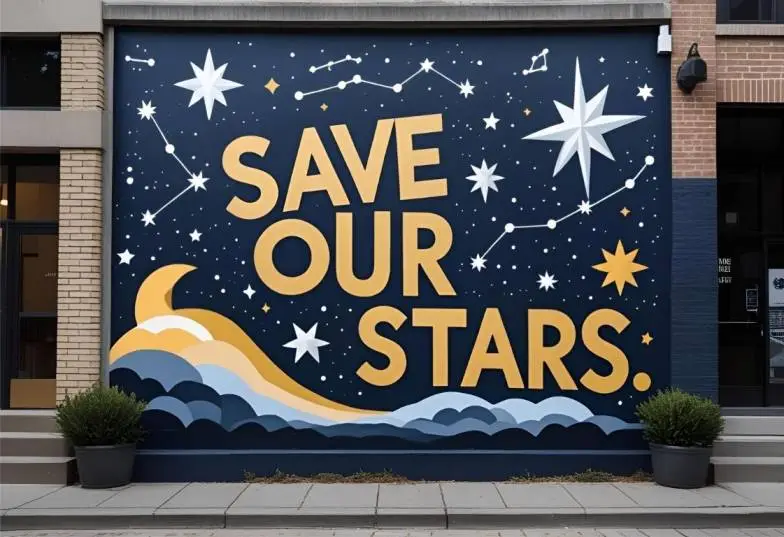
Here are some urban engagement ideas:
- Wall art in housing societies reminds residents to turn off outdoor lights.
- Street murals in collaboration with local artists and NGOs.
- “Dark Sky Drawing Days,” where children and adults create posters in parks or public spaces.
These activities often bring together urban families, eco-volunteers, and art enthusiasts, creating a sense of shared purpose.
🎨 Pro Tip: If you’re organizing an awareness event, include a drawing contest. Choose themes like “Save Our Stars” or “My Night Sky Dream” and invite local kids. The visual impact of their creations can be far more powerful than just facts.
Art isn’t just decoration—it’s a tool for change.
🌟 Section 4: Success Stories – Indian Communities Leading the Change
These community art initiatives aren’t just feel-good projects—they’re creating measurable change across India. Let’s look at some inspiring examples of how drawings and visual awareness have translated into real environmental victories.
🏫 School Champions
Kendriya Vidyalaya, Pune – “Operation Starlight”
In 2024, this central government school launched an innovative month-long project where Class 9 students measured light pollution levels around their campus using smartphone apps. The results were eye-opening: the school’s security lighting was creating significant skyglow. Working with their science teachers, students convinced the administration to install shielded LED fixtures, reducing upward light spillage by 70%. The project’s success led to its adoption across 12 other KV schools in Maharashtra.
DPS Bangalore East – “Draw the Dark” Campaign
This Delhi Public School made headlines when their annual art exhibition featured entirely dark sky-themed artwork. Over 200 students from grades 6-12 participated, creating everything from simple sketches to detailed infographics about light pollution. The exhibition attracted over 1,000 parents and community members, leading to three neighboring apartment complexes retrofitting their common area lighting. The school now hosts quarterly “Lights Off” stargazing nights for families.
🏘️ Community Victories
Prestige Lakeside Habitat, Bangalore – India’s First “Dark Sky Society”
This 500-apartment residential complex became a pioneer when residents voted to implement dark-sky-friendly lighting in 2024. The transformation included:
- Replacing 150 ornamental lights with warm-toned, shielded fixtures
- Installing motion sensors in common pathways
- Creating designated “stargazing zones” with minimal lighting
- Results: 60% reduction in electricity consumption for outdoor lighting, increased bird species count from 12 to 28, and over 80% resident satisfaction in post-implementation surveys.
Koramangala Astronomy Group, Bangalore
This community group has been conducting regular astrophotography workshops and awareness events that have directly influenced local lighting policy. Their “Adopt a Street Light” campaign convinced the BBMP to replace 50 harsh LED streetlights with warmer, directional alternatives along key residential roads.
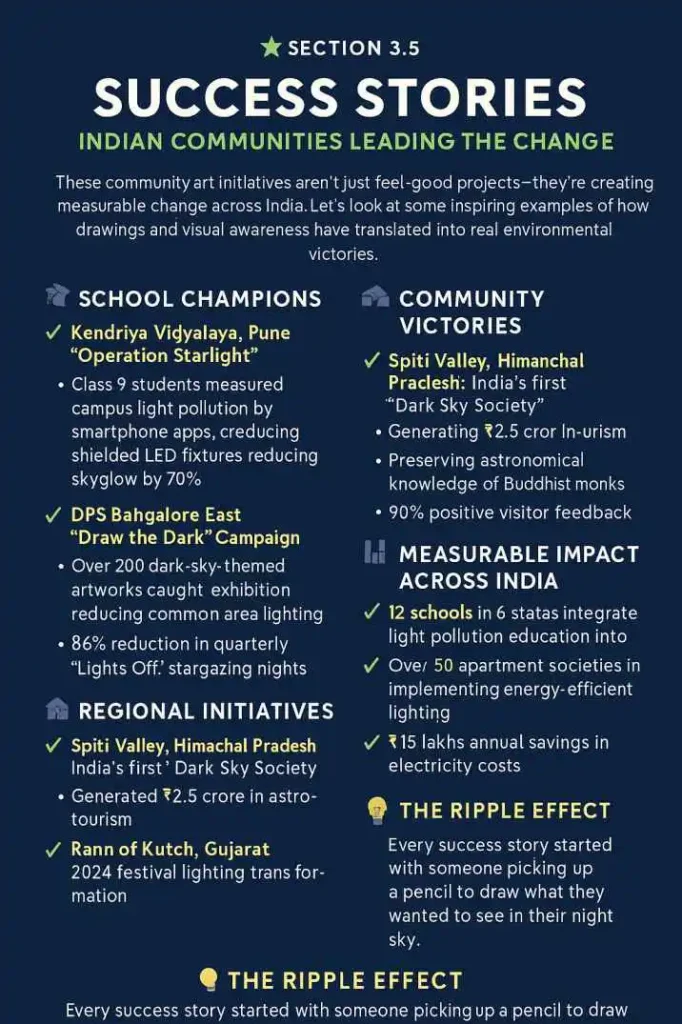
🏞️ Regional Initiatives
Spiti Valley, Himachal Pradesh – “Himalayan Dark Sky Reserve” Project
While not yet officially certified, this high-altitude desert region has become India’s unofficial dark sky destination. Local monasteries and guesthouses have voluntarily adopted minimal lighting practices, creating an extraordinary stargazing experience that’s attracting eco-tourists. The initiative has:
- Generated ₹2.5 crore in astro-tourism revenue for local communities
- Preserved traditional astronomical knowledge of Buddhist monks
- Influenced lighting policies in the nearby Lahaul-Spiti district
Rann of Kutch, Gujarat – Festival Lighting Transformation
During the 2024 Rann Utsav, organizers implemented India’s first “dark sky festival” approach. Instead of flooding the white salt desert with harsh lights, they used minimal, ground-level illumination that preserved the natural night sky experience. Visitor feedback was overwhelmingly positive, with 90% rating the stargazing experience as “life-changing.”
📊 Measurable Impact Across India
Recent data shows the growing success of grassroots dark sky initiatives:
- 12 schools across 6 states have integrated light pollution education into their curricula
- Over 50 apartment societies have implemented energy-efficient, dark-sky-friendly lighting
- ₹15 lakhs saved annually in electricity costs across participating communities
- 300% increase in participation in astronomy clubs and stargazing events in metro cities
💡 The Ripple Effect
What makes these success stories particularly powerful is their viral nature. The Pune KV project inspired similar initiatives in government schools across three states. The Bangalore apartment complex model is being studied by residential societies in Mumbai, Chennai, and Hyderabad.
These aren’t just environmental wins—they’re proof that when communities see the stars return to their night sky, the impact goes far beyond reduced light pollution. Families spend more time outdoors together, children develop interests in science and astronomy, and neighbors collaborate on shared environmental goals.
🎯 Key Takeaway: Every success story started with someone picking up a pencil to draw what they wanted to see in their night sky. Whether it’s a student’s poster, a community meeting presentation, or a simple before-and-after sketch shared on social media, visual communication continues to be the catalyst for real, measurable change in India’s fight against light pollution.
🌌 Section 5: How You Can Support the Dark Sky Movement
🏠 Practical Steps for Indian Households Supporting the Dark Sky Movement doesn’t mean turning off all lights—it means using smarter, responsible lighting. Even small changes at home can reduce light pollution and save electricity.

Here are easy actions you can take in your home:
- Use warm, focused lighting: Switch to LED bulbs with lower wattage (2700K–3000K) and direct them downward.
- Turn off lights when not in use: Especially outdoor and balcony lights after 10 PM.
- Install motion sensors or timers: Great for garden lights or stairways to avoid unnecessary illumination.
- Shield outdoor lights: Use fixtures with covers that prevent light from spilling upwards.
- Switch to curtains or blinds: This helps reduce light trespass to your neighbors.
🧠 Fun Fact: A typical Indian household can cut its outdoor lighting energy use by up to 50% with smarter lighting habits—saving both stars and electricity bills.
🖌️ Creative Ways to Use Drawings and Visual Media If you’re an artist, student, parent, or creator, you can use visuals to amplify the movement. Here’s how:
Share light pollution drawings online: Post on Instagram, Pinterest, or your school’s WhatsApp group with hashtags like #DarkSkyIndia or #SaveOurStars.
Create infographics or short videos: Explain skyglow or safe lighting tips through reels, Canva graphics, or comic panels.
Make posters for awareness events: Useful for apartment meetings, school exhibitions, or local environment days.
Build a drawing wall at home: Encourage kids to sketch night skies, planets, and the Milky Way—fun and educational!
Participate in global campaigns: Groups like the IDA or local astronomy clubs often run online drawing contests.
📱 Indian Example: An NGO in Bengaluru runs an annual “Lights Off for the Stars” drawing competition on World Environment Day. Kids submit their artwork online, and winners get featured in a digital gallery. It’s fun, inclusive, and spreads awareness across thousands.
No matter your age or background, you can be part of the movement. All it takes is a pencil, a message, and the will to make our nights a little darker—and our skies a lot brighter.
India is also embracing dark sky tourism. Astronomy clubs like Jyotirvidya Parisanstha in Pune and national institutions like the Astronomical Society of India are working to promote public awareness and research.
🎨 Dark Sky Drawing Worksheets – Complete Educational Package [NEW]
📚 Age Group 1: Primary School (Ages 6-9) – “Little Star Seekers”
📚 Age Group 2: Middle School (Ages 10-13) – “Sky Detectives”
📚 Age Group 3: High School (Ages 14-18) – “Dark Sky Advocates”
📋 Universal Worksheet Templates Available for Download
👉 [Download Complete Educational Package – PDF]
✅ Conclusion
Light pollution is often overlooked, but its impact is as real as air or water pollution. The Dark Sky Movement reminds us that we don’t need to light up the world to live well. Protecting the night sky can improve our health, conserve energy, support wildlife, and reconnect us with nature.
As we’ve seen, even a simple drawing can spark change. Whether it’s a child’s sketch in a school notebook or a mural on a city wall, visual art brings light to the problem and hope to the solution. From students and parents to eco-conscious creators, each of us can support this movement in our own way.
So here’s your call to action: 🔭 Look up tonight. Can you see the stars? If not, maybe it’s time to pick up a pencil, draw what’s missing, and share your vision. Together, we can reclaim the night sky—one drawing and one lightbulb at a time.

🔭 Want to explore more?
• NASA’s Night Sky Network – Events & guides for stargazers
• National Geographic Kids: Light Pollution – Simplified science for young minds
• Indian Science and Technology Portal – Educational support from the Government of India
❓ Frequently Asked Questions (FAQs)
Q: What is the Dark Sky Movement, and why is it important?
A: The Dark Sky Movement is a global initiative to reduce light pollution and protect our view of the night sky. It promotes better lighting practices to help wildlife, save energy, and allow people to enjoy starry skies again.
Q: How does light pollution affect us in India?
A: In Indian cities, excessive artificial lighting leads to disturbed sleep, wasted electricity, and reduced visibility of stars. It also affects migratory birds, insects, and even human health.
Q: Can drawings help fight light pollution?
A: Yes! Drawings make complex issues like light pollution easy to understand. Schools, NGOs, and creators use visual art to raise awareness and spark action, especially among young people.
Q: What are some common types of light pollution?
A: The main types include:
Skyglow (urban sky haze)
Glare (harsh brightness)
Light trespass (unwanted light entering homes)
Clutter (excessive outdoor lighting in one area)
Q: How can I reduce light pollution at home?
A: Simple steps include:
Turning off unnecessary lights
Using shielded outdoor fixtures
Choosing warm-colored LED bulbs
Installing motion sensors for security lighting
Q: Are there any dark sky initiatives in India?
A: Yes! Indian cities like Pune and Bhopal have held dark sky awareness events. Some stargazing spots in Ladakh and Uttarakhand are also promoting low-light eco-tourism.
Q: Where can I share my light pollution drawings or projects?
A: You can post them on social media with hashtags like #DarkSkyIndia, participate in school competitions, or submit artwork to environmental NGOs and online campaigns.
👉 Click here to download the Dark Sky Drawing Worksheet (PDF)
Want to learn more about Light Pollution Drawing?
- Disturbing Light Pollution: Drawing Truths That Will Haunt You →
- How to Make a Light Pollution Drawing for a School Project (Step-by-Step Guide)
- Top 5 Light Pollution Drawing Messages for Students & Artists: Raise Awareness with Art
- Simple vs. Advanced Light Pollution Drawings: What’s the Difference? → will be coming to our site soon!
You May Also Like
- What is Light Pollution? – A Definitive Guide for Researchers
- Zero-Waste Living for Eco-Conscious Families
- Solutions to Thermal Pollution: A Cooler Planet
- The Ultimate Guide to Creating a Thriving Balcony Garden
About the Author
Soumen Chakraborty is an environmental writer who is passionate about sustainable solutions. He has researched and written about environmental issues for two years, breaking down complex topics into practical, actionable insights.
🌍 “Every small action matters in protecting our planet.”

